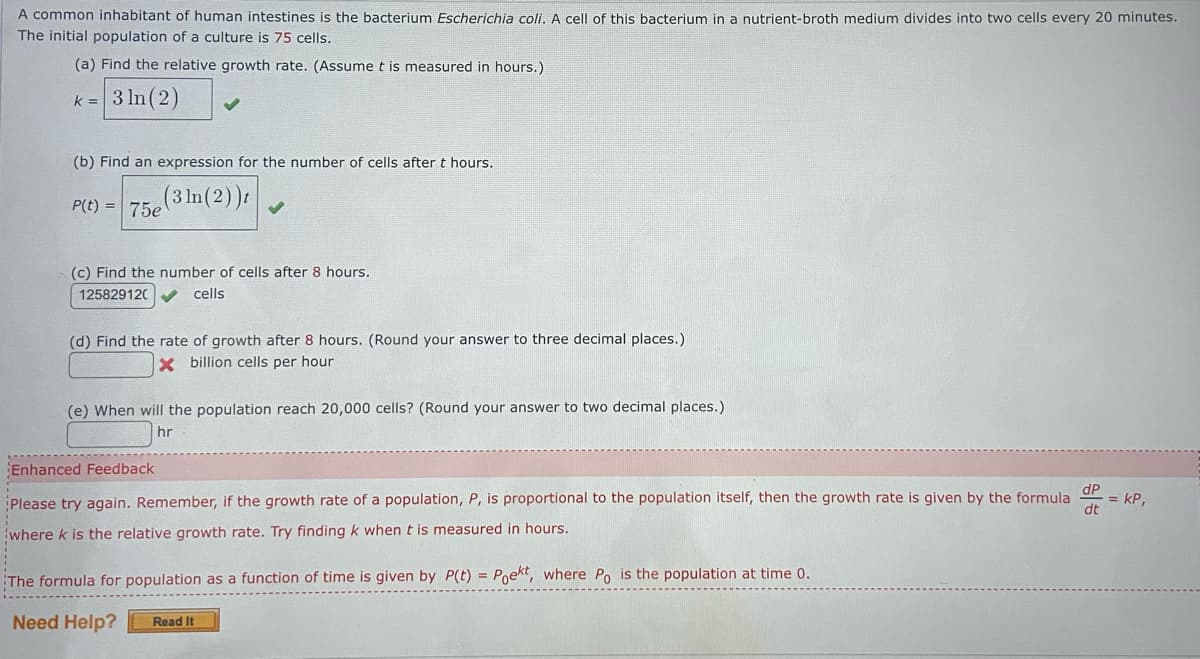A common inhabitant of human intestines is the bacterium Escherichia coli. A cell of this bacterium in a nutrient-broth medium divides into two cells every 20 minutes. The initial population of a culture is 75 cells. (a) Find the relative growth rate. (Assume t is measured in hours.) k= 3 ln(2) (b) Find an expression for the number of cells after t hours. P(t) = 75e (3 ln(2)), (c) Find the number of cells after 8 hours. 125829120✓ cells (d) Find the rate of growth after 8 hours. (Round your answer to three decimal places.) X billion cells per hour (e) When will the population reach 20,000 cells? (Round your answer to two decimal places.) hr Enhanced Feedback Please try again. Remember, if the growth rate of a population, P, is proportional to the population itself, then the growth rate is given by the formula where k is the relative growth rate. Try finding k when t is measured in hours. dP dt = KP,
A common inhabitant of human intestines is the bacterium Escherichia coli. A cell of this bacterium in a nutrient-broth medium divides into two cells every 20 minutes. The initial population of a culture is 75 cells. (a) Find the relative growth rate. (Assume t is measured in hours.) k= 3 ln(2) (b) Find an expression for the number of cells after t hours. P(t) = 75e (3 ln(2)), (c) Find the number of cells after 8 hours. 125829120✓ cells (d) Find the rate of growth after 8 hours. (Round your answer to three decimal places.) X billion cells per hour (e) When will the population reach 20,000 cells? (Round your answer to two decimal places.) hr Enhanced Feedback Please try again. Remember, if the growth rate of a population, P, is proportional to the population itself, then the growth rate is given by the formula where k is the relative growth rate. Try finding k when t is measured in hours. dP dt = KP,
Trigonometry (MindTap Course List)
10th Edition
ISBN:9781337278461
Author:Ron Larson
Publisher:Ron Larson
Chapter5: Exponential And Logarithmic Functions
Section5.5: Exponential And Logarithmic Models
Problem 2ECP
Related questions
Question
100%
I need help with d and e

Transcribed Image Text:A common inhabitant of human intestines is the bacterium Escherichia coli. A cell of this bacterium in a nutrient-broth medium divides into two cells every 20 minutes.
The initial population of a culture is 75 cells.
(a) Find the relative growth rate. (Assume t is measured in hours.)
k= 3 ln (2)
(b) Find an expression for the number of cells after t hours.
(3 ln(2))t
P(t)= 75e
(c) Find the number of cells after 8 hours.
125829120
cells
(d) Find the rate of growth after 8 hours. (Round your answer to three decimal places.)
X billion cells per hour
(e) When will the population reach 20,000 cells? (Round your answer to two decimal places.)
hr
Enhanced Feedback
Please try again. Remember, if the growth rate of a population, P, is proportional to the population itself, then the growth rate is given by the formula.
where k is the relative growth rate. Try finding k when t is measured in hours.
The formula for population as a function of time is given by P(t) = Poekt, where Po is the population at time 0.
Need Help? Read It
dP
dt
= KP,
Expert Solution
This question has been solved!
Explore an expertly crafted, step-by-step solution for a thorough understanding of key concepts.
Step by step
Solved in 3 steps

Recommended textbooks for you

Trigonometry (MindTap Course List)
Trigonometry
ISBN:
9781337278461
Author:
Ron Larson
Publisher:
Cengage Learning



Trigonometry (MindTap Course List)
Trigonometry
ISBN:
9781337278461
Author:
Ron Larson
Publisher:
Cengage Learning



Algebra & Trigonometry with Analytic Geometry
Algebra
ISBN:
9781133382119
Author:
Swokowski
Publisher:
Cengage